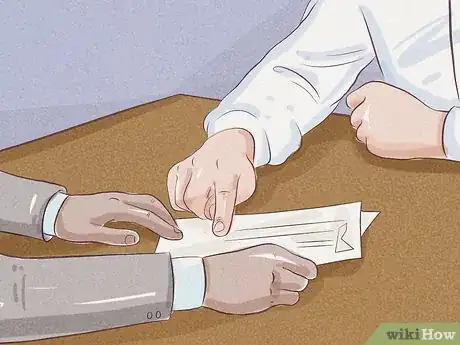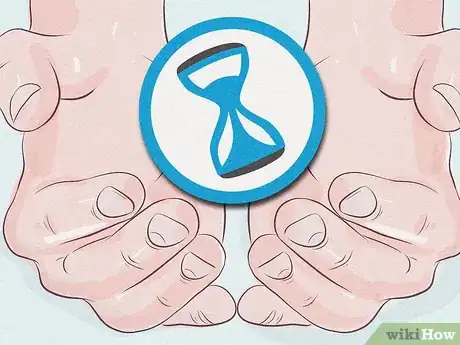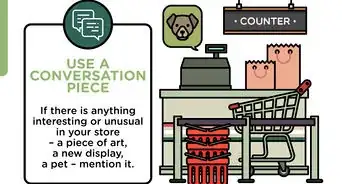This article was co-authored by Michael R. Lewis. Michael R. Lewis is a retired corporate executive, entrepreneur, and investment advisor in Texas. He has over 40 years of experience in business and finance, including as a Vice President for Blue Cross Blue Shield of Texas. He has a BBA in Industrial Management from the University of Texas at Austin.
There are 15 references cited in this article, which can be found at the bottom of the page.
wikiHow marks an article as reader-approved once it receives enough positive feedback. In this case, 89% of readers who voted found the article helpful, earning it our reader-approved status.
This article has been viewed 120,287 times.
No matter what line of work you're in, if you deal with clients you need to maintain a professional attitude and demeanor at all times. This includes not just what you say, but how you say things and how you conduct yourself. Talking to a client without the right tact and professional courtesy could end up losing business for your company. Learning how to talk to a client and work with difficult clients can help improve your professional relationship and may help further your career.
Steps
Communicating Effectively with a Client
-
1Understand the client's needs. Knowing what a client wants requires you to understand what the client's end vision is, as well as what the client's history is. You should have a clear idea of how a given project or case fits in with the client's goals and personality. This can give you a better picture of how important that issue is for the client.[1]
- Ask good questions to get to know what your client wants. Be as specific as possible, and ask your client to be specific and clear as well.
- For example, as an investment advisor, you might ask your client, "Are you willing to lose 10% of your investment to make 20%?", "How do you feel about losses?", and "Do you worry at night about your investments?"
- A lawyer might asks a client questions like, "What is your ideal result from these proceedings?" or "How aggressively do you want to pursue this?"
-
2Be a good listener. Good listening skills are important in any business partnership. Take the time to really listen to your client. If you don't understand why something is important to a client, you're probably not listening or asking the right questions. Follow up with more specific questions and listen to what your client has to say.[2]
- Don't interrupt your client. Use neutral expressions to encourage your client to speak more, such as "Go on," "I see," and "Yes, I understand."
- Maintain eye contacts and take short notes where possible.
- Nod your head gently and/or smile (if appropriate) to show that you're listening. Make sure you're paying attention, though; smiling while your client talks about losing money will reflect poorly on you.
- Try to rephrase what your client says to ask follow up questions. For example, if your client says they're unhappy with their returns, you might say, "I can understand why you're unhappy. What type of return would be ideal for your investment?"
Advertisement -
3Provide clarity for your client. Clarity is vital in any dealing with your client. Your client always needs enough information to make an informed decision. If you're not being clear with your client, they won't be able to make that decision and may end up losing trust in you.[3]
- Part of being clear with a client involves using language that the client will understand. For example, if the client doesn't understand technical jargon, then rephrase everything in ways the client will understand.
- You should also be clear on what you are doing at any given step, the results you expect, and why. If your client doesn't understand your rationale or how a given move will help them, they may reject your idea or be reluctant to support it.
- Even minor changes like delegating some minor work to a subordinate or colleague could be upsetting to the client if you don't inform them about it. Just let your client know what you're doing ahead of time and why.
-
4Document every interaction with the client. It's generally good practice to keep some type of log of your interactions with your client. This may come in handy if you need to prove to management that you've been keeping client hours. It may also be helpful to have clear and professional documentation in case your client asks to see proof of something from one of your interactions.
- Any interaction you have with a client should be documented, including face-to-face meetings, phone class, voicemails, text messages, and emails.
- Record the client's name, the date (and time, if possible), the nature of your contact with one another, how much time was spent communicating, and details of who said what.
- It's always a good practice to send confirming note/email about your understanding of the agreement(s) reached during the interaction, time schedule, and deliverables. This is just another step to ensure you and clients are on the same page.
Interacting with Clients
-
1Remain professional at all times. No matter what type of interaction you're having with a client, you'll need to remain professional in every capacity. That includes the way you speak, the things you say, and the way you carry yourself in front of your client.[4]
- Don't be overly casual. Remember that you're dealing with a client, not a friend, so don't use curse words, tell inappropriate jokes, or use text speak or emojis with a client.
- Always double-check your grammar and spelling. A glaring error can be embarrassing and may look unprofessional.
- Ask about your client's personal life if they reveal any details, but don't pry or get too overly-familiar with the client. It may require trial and error to find a good balance.
- Say polite and appropriate things like, "It's great to see you. How was your weekend?"
- Avoid polarizing or inappropriate topics like politics, religion, social issues, and romantic endeavors.
-
2Be proactive. Failing to be proactive can be frustrating for clients, and it may end up damaging your professional relationship. Always be the one to initiate correspondence, especially when something new comes up that your client will want to know about.[5]
- Don't wait for your client to call you with news that affects them; break that news to the client, and your client will recognize your value. Constantly monitor news feeds for important information.
- However, don't report rumors unless it is something that will affect the value of your client's asset(s). Check your sources before contacting your client.
- Have an opinion on the things you inform your client of, and be bold and firm in your opinion.
- For example, if your client isn't sure about which stocks to invest in, you might say "Based upon your desire for income and limited risk, I think your should consider _____ because _____."
- Or, as a doctor, you should contact your patient when a test result of theirs comes back or when you hear of a new treatment for a medical issue they have.
- Don't wait for your client to call you with news that affects them; break that news to the client, and your client will recognize your value. Constantly monitor news feeds for important information.
-
3Respect your client's time. While you should contact your client on a regular basis, you also don't want to take up too much of their time. Generally speaking, unless a client requests more time or has pressing matters that require greater attention, most phone calls should last no more than 10 to 15 minutes.[6]
- Don't call your clients for idle chit chat. They're busy and so are you, so keep your contact as professional as possible unless your client reaches out to you socially.
-
4Ask your client for their thoughts and opinions. Any time you discuss new business, ask your client what they think about the information you've shared. You should be giving your opinions on the matters you discuss with your client. Ask their opinion of the information you've relayed to determine whether your views coincide.[7]
- Acknowledge and respect the client's opinion. Even if you disagree, say something like, "Yes, I can see your point."
- If you know that a client is wrong and that they're setting up for a failure or a huge loss of money, don't be afraid to speak up.
- Avoid telling a client he/she is wrong as it will make them defensive. Instead, ask questions like "Have you considered ______?" or "What if _____ happens?"
- Alternately, a lawyer might ask a client if they understand the actions being taken and whether or not they agree with the tactic being used.
-
5Pay attention to body language. Body language can betray a lot of emotions whether you're aware of it or not. This can work to your advantage, as you'll be able to read your client's body language, but your own body language can also betray you to a client.[8]
-
6Be aware of your tone and demeanor. Just as body language can betray unspoken feelings, so too can tone and demeanor. Be aware of the tone you're using and what that might convey to a client so that you can correct your tone or expressions as needed.[12]
- Make sure your tone matches your facial expression.[13]
- Check that your tone also matches the words that you're saying.[14] If your words are conveying agreement but your tone conveys frustration, your client will pick up on this.
- Be sure to smile when you talk, especially over the phone. Doing so helps tone of voice sound optimistic and open.
Dealing with Difficult Clients
-
1Stay in control of your emotions. Sometimes a client may be difficult to work with, but in these cases you'll need to remain even more in control of yourself. Losing control of your emotions with a client could ruin your business with that individual, and it could even cost you your job.[15]
- Do not give an emotional response to anything your client says or does. Be respectful and remember that the client is always right.
- Remember the importance of being professional, even in the face of abuse.
- If you're really struggling to control your emotions, try counting to ten or taking a few deep breaths before saying anything.
-
2Spend more time listening than speaking. It's generally a good idea to let a client speak freely, but this is more important than ever when the client is being difficult. Your client may be uncooperative because they feel that they're not being heard, so letting your client do most of the talking in tense moments may help defuse the situation.[16]
- You can communicate a great deal with silence. Let your client talk, and respond when appropriate.
- Ask follow-up questions to reflect on or clarify anything you're not clear about. For example, you might say, "I think I see what you mean, but I'm a little confused about _____; could you clarify what you meant by that?"
-
3Show that you're engaged. When a difficult client doesn't feel heard, that client may become more uncooperative. Engaging in small conversational habits to show engagement and concern can help reassure your client and make the situation less tense.[17]
- Make eye contact with the client while you're speaking to one another.
- Use short, small verbal cues to show that you're listening. For example, saying "Mhmm" or "Yes," or even just nodding in agreement, shows that you're engaged.
-
4Speak with confidence. How you say things can be just as important as what's actually being said. When you have a difficult client, it's important to be aware of how you're coming across in your manner of speech. Changing your voice's speed and pitch may help calm an irate client, especially when combined with other conversational techniques.[18]
- Slow down the speed of your speech and lower the pitch and volume of your voice.
- Speaking slowly and softly can have a calming effect on upset or anxious clients. Try to make the shift noticeable so that your client will pick up on it subtly.
-
5Fulfill the client's wishes. Sometimes agreeing with a difficult client is the best way to placate a bad attitude. Even if you know the client is wrong, it may be best to avoid challenging a difficult client if there's no other way to calm them down.[19]
- Voice your concerns if the client is about to make a huge mistake, but remember that the decision is ultimately up to the client to make.
-
6Fire a client as a last resort. If you can't placate a client or meet their demands despite your best efforts, it's best just to let them go. Yes, you will lose their business, but in some cases it may not be worth the headache to keep them.
References
- ↑ https://www.infoentrepreneurs.org/en/guides/know-your-customers--needs/
- ↑ https://www.psychologytoday.com/blog/in-the-face-adversity/201111/being-good-listener
- ↑ https://www.indeed.com/career-advice/career-development/phone-skills
- ↑ https://www.indeed.com/career-advice/career-development/how-to-deal-with-difficult-customers
- ↑ https://insight.kellogg.northwestern.edu/article/five-ways-to-authentically-engage-your-customers
- ↑ http://www.forbes.com/sites/patrickhull/2013/05/08/tips-for-talking-to-customers/#313343847d84
- ↑ http://www.forbes.com/sites/theyec/2013/09/17/three-ways-to-improve-your-communication-with-clients/#520c7f2237e4
- ↑ https://blog.hubspot.com/service/body-language-in-customer-service
- ↑ http://www.forbes.com/pictures/lml45lide/bad-posture-2/#2186e7cd6be4
- ↑ http://www.forbes.com/pictures/lml45lide/crossed-arms-2/#5ad6793661f7
- ↑ http://www.forbes.com/pictures/lml45lide/fidgeting-2/#6db6148e13d5
- ↑ https://www.indeed.com/career-advice/career-development/how-to-deal-with-difficult-customers
- ↑ http://www.forbes.com/pictures/lml45lide/mismatched-expressions-2/#744f86e2a07f
- ↑ https://www.psychologytoday.com/blog/happiness-in-world/201008/the-importance-tone
- ↑ https://www.entrepreneur.com/article/240765
- ↑ https://blog.hubspot.com/service/how-to-deal-with-difficult-customers
- ↑ https://www.entrepreneur.com/article/240765
- ↑ https://www.entrepreneur.com/article/240765
- ↑ https://blog.hubspot.com/service/how-to-deal-with-difficult-customers
About This Article
To talk to a client, try to remain professional at all times by avoiding overly casual language and inappropriate topics. Remember to smile when you're talking and to use a calm, friendly tone, even if you're feeling a little frustrated or confused. Also, throughout the conversation, ask your client for their thoughts and opinions by saying things like "Are you comfortable with that?" or "Will that work for you?" so you know you're on the same page. In general, try to limit your conversation to 10-15 minutes to respect your client's time. To learn how to deal with difficult clients, scroll down!













































































